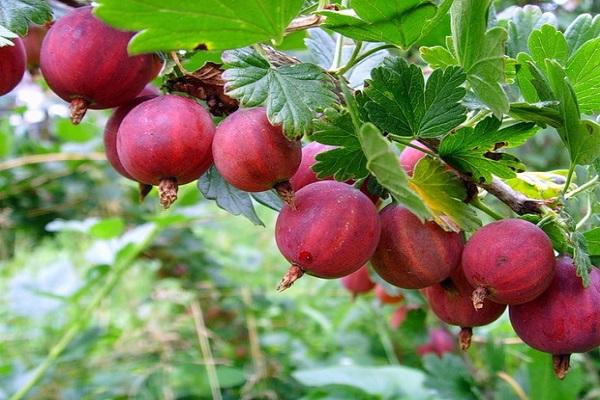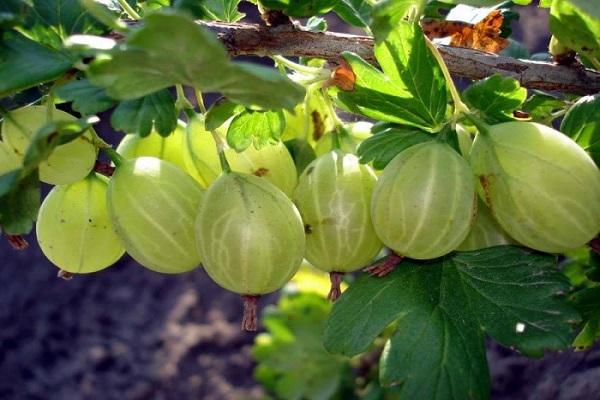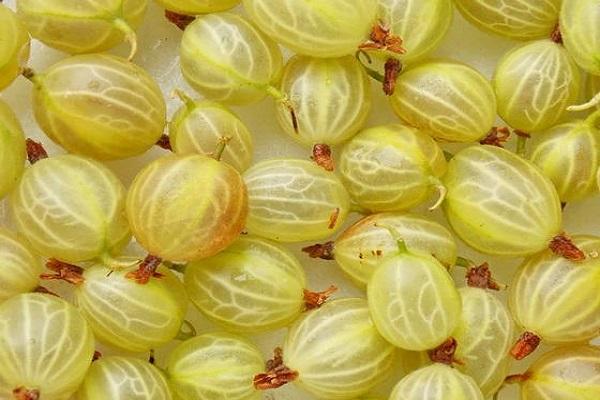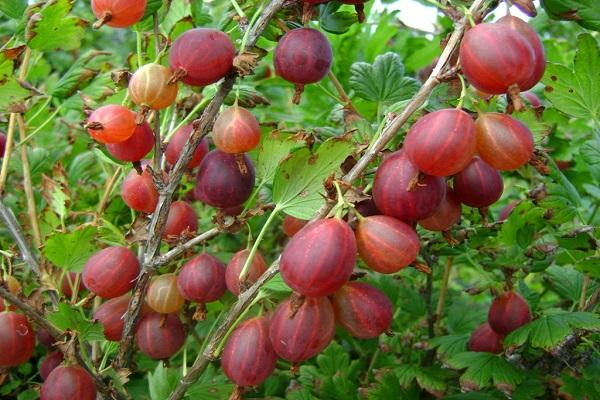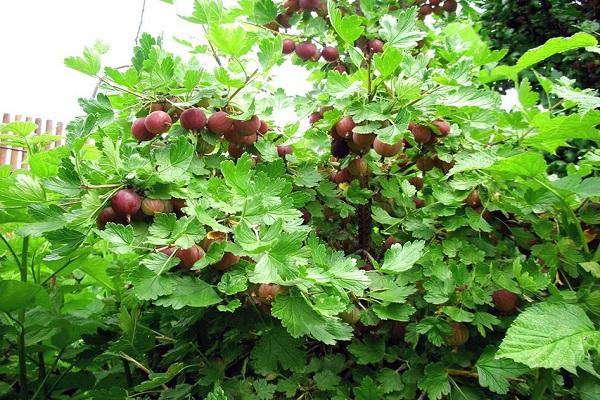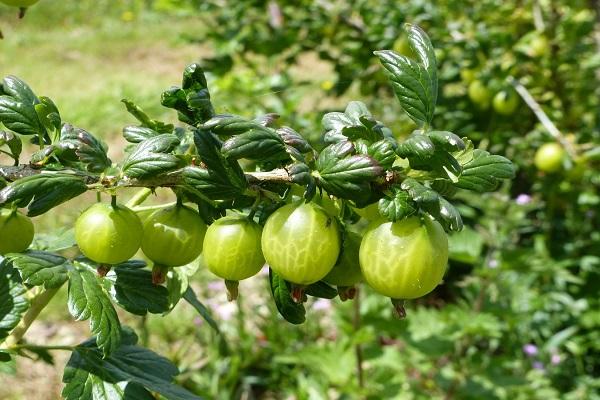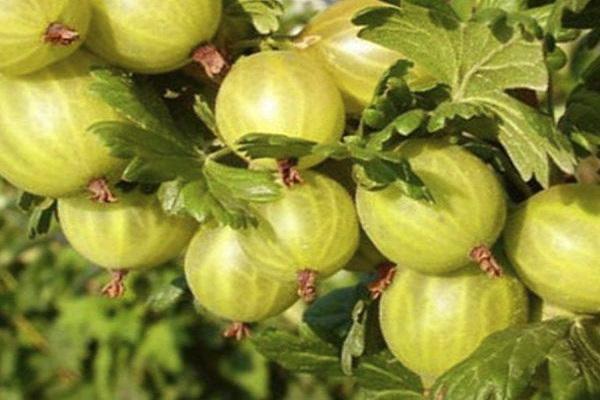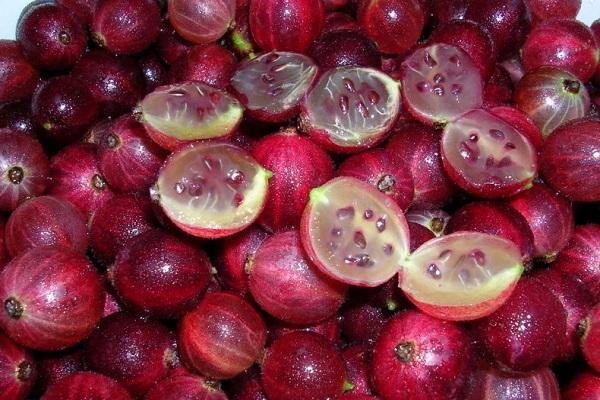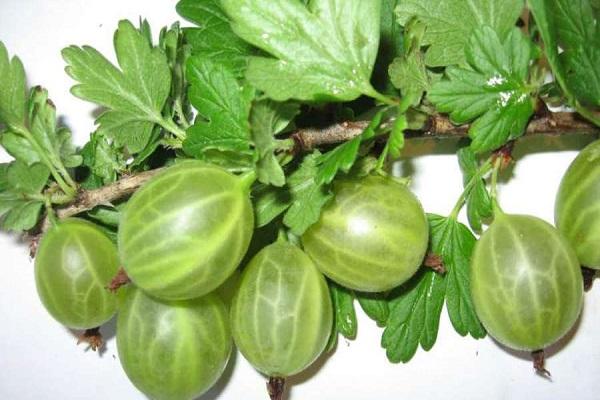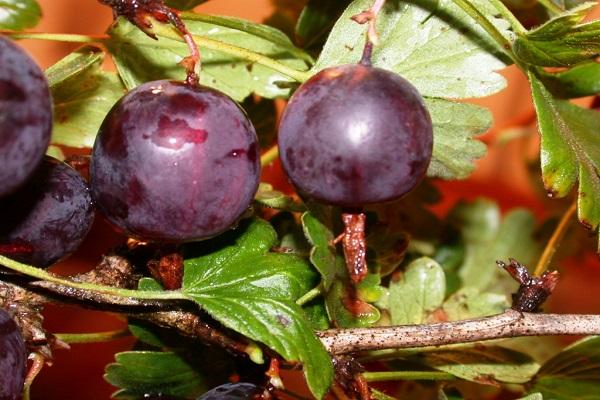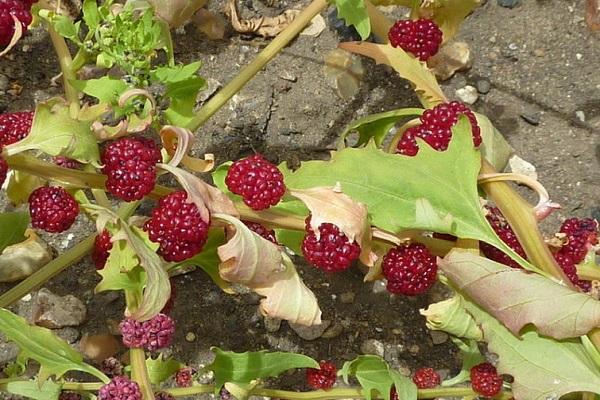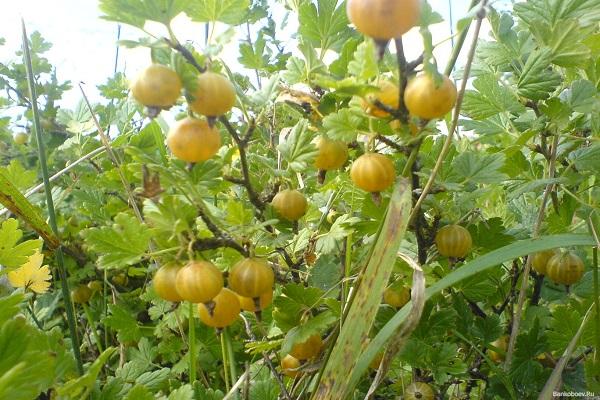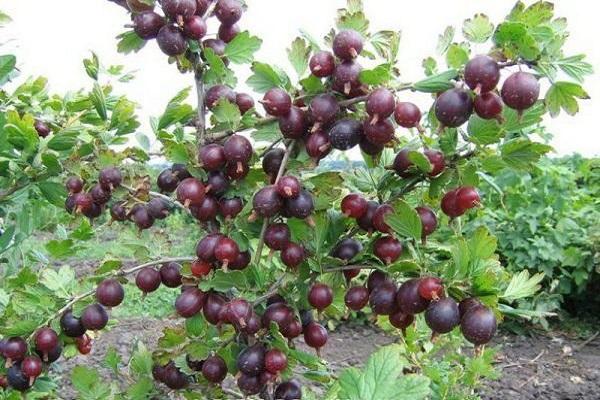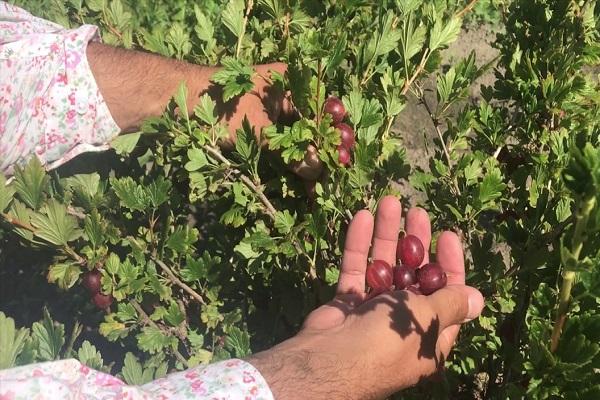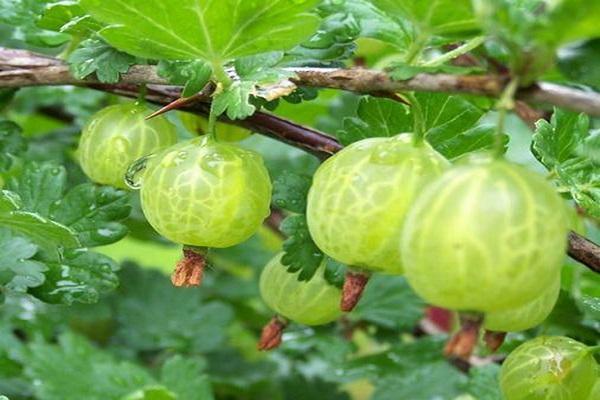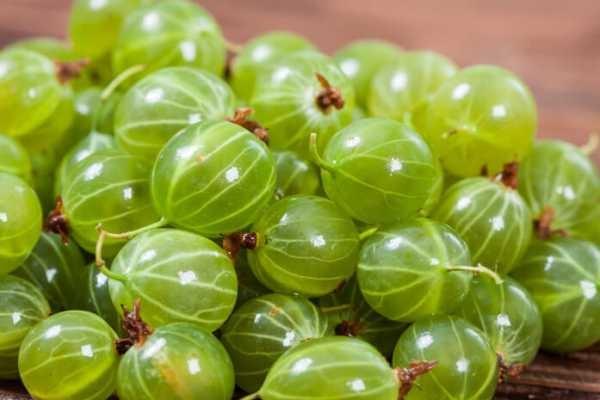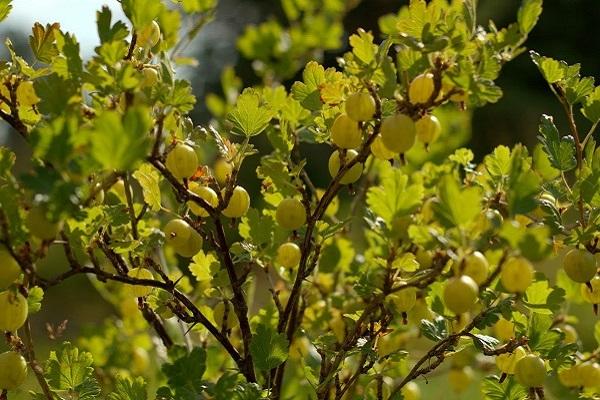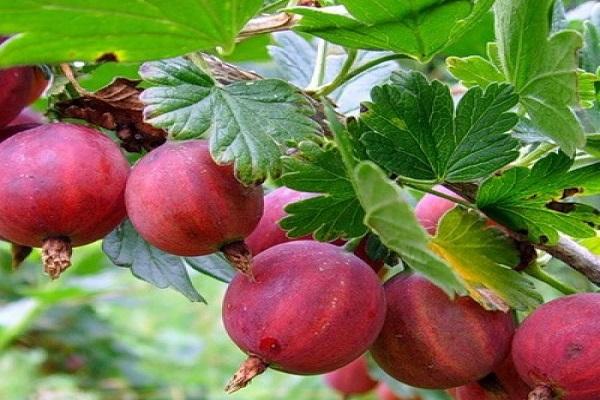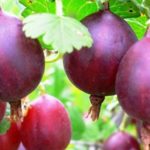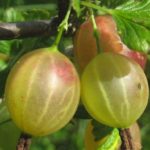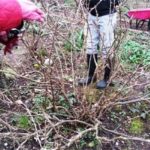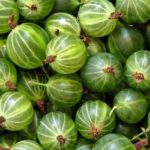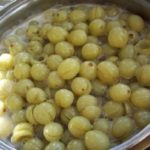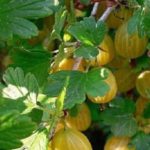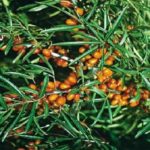To decide which variety of gooseberries to plant at your summer cottage, it is important to study the characteristics of the bushes. Decide what you want to get as a result: a thornless bush with large berries, or maybe you’ll be interested in a gooseberry with sweet fruit pulp. But it is mainly important to take into account the region of growth, the severity of the winter season or other climatic features.
- Popular gooseberry varieties
- Bright
- Baltic
- Gentle
- Affectionate
- Freedonia
- Wine
- Lada
- Royal
- Coral
- Peach
- Phoenix
- Cardinal
- Michurinets
- Muscat
- Classification of varieties by ripening time
- Early
- Average ripeness
- Late
- Large-fruited varieties
- Defender
- Leningradets
- Spring
- Frost-resistant gooseberry varieties
- Krasnoslavyansky
- Consul
- Beryl
- Ural emerald
- Belorussian
- The best thornless gooseberry varieties
- Thornless gooseberry
- Northern captain
- African
- Eaglet
- Strawberry
- Kuršu Dzintars
- Altai license plate
- Grossular
- The sweetest varieties
- Belarusian sugar
- Cooperator
- Seedling Lefora
- Candy
- Pink 2
- White Nights
- Classification of varieties by berry color
- Chokeberry crops
- Red varieties
- Green-fruited varieties
- Yellow-fruited
- Tips for choosing a variety for different regions of Russia
- Moscow region and central zone
- Grushenka
- Russian yellow
- Kolobok
- Amber
- For regions of Siberia
- For the Urals
Popular gooseberry varieties
Types of gooseberries differ from each other: they are characterized by different ripening periods, fruit size and color. Some of them are allowed to be grown in all regions, some exclusively in the southern climate. There are plants cultivated in the northern regions.
Bright
Shrub of medium spreading and growth, dense. The thorniness is distributed along the entire branch. The berries are medium in size, up to 5.5 g, pinkish, gray, slightly shaggy, sour-sweet, rounded in shape. Winter-hardy, productive shrub.
Baltic
Compact, spherical shrub, medium height. The branches are extremely thorny, containing small berries, weighing up to 4 g, of a greenish-light hue. It is characterized by a sour, pleasant aftertaste. A plant with increased resistance to anthracnose is recognized as winter-hardy.
Gentle
Late variety, thornless, medium-sized shrub. The berries have a greenish color, sweet pulp with a pleasant aroma. Gooseberry weight is 5 g. It is characterized by a yield of up to 5.8 kg per bush and high resistance to frost.
Affectionate
Berries with an average weight of 6.5 grams, have a round, even oval, shape, a rich red tone, covered with a shaggy coating. Fruits with tasty pulp and a peach aroma. A medium-sized shrub with slightly thorny shoots. Brings up to 7.5 kg annually. A highly winter-hardy plant that is resistant to powdery mildew.
Freedonia
The plant is thornless, medium-sized. The fruit tastes like a mixture of strawberry and pineapple. The color of the fruit is red. Characterized by immunity to powdery mildew.
Wine
The plant produces a sweet fruit, but requires timely harvesting, otherwise the fruits will turn sour. Hence the name it got. Overripe berries have the smell of alcohol. Rapid decay begins.
Lada
It is among the species that have good immune protection against common fungal infections. Late ripening. Medium-sized shrubs with a wide crown. The fruits are pleasantly sweet, large, weighing from 5 to 8 g, increased productivity.
Royal
Gooseberries live up to their name: the fruits are large, sweet, and light green in color. Characterized by increased productivity. The branches contain infrequent thorns. Medium spreading plant.
Coral
Bush of early ripening period, vigorous, not spreading, branches strongly thorny, with small fruits (up to 4.5 g). But they have sweet and juicy green flesh with a yellow tint, and are a little shaggy.
Peach
A medium-sized, medium-spreading, winter-hardy shrub with large, amber-colored fruits that have a pleasant sweet-sour taste and stay on the stalks for a long time without falling off.
Phoenix
Shrub of medium ripening period, with average resistance to frost. Productivity - up to 4.6 kg per bush.The medium-height, semi-spreading shrub requires care. The fruits are oval-round, average weight up to 10 g.
Cardinal
Another name for Commander. The bush is of medium height, has no thorns. The berry is round in appearance, dark red, medium-sized (up to 7 g), and has a thin skin. Classified as a non-transportable variety.
Michurinets
Medium ripening period. The shrub is medium-sized and medium-spreading. The branches are thick, curved, and there are numerous thorns. The fruits are medium-sized, similar to pears, dark reddish in color, with a rich waxy edge. The taste is sweet and sour. Average productivity - 5.3 kg.
Muscat
The gooseberry is medium-sized, up to 6.8 g, characterized by a red tint, oval in appearance. The pulp is sweetish, tender, with a sugary aroma. Plant of mid-ripening period. Productivity ranges from 8.5 kg to 10.5 kg. A winter-hardy shrub that is immune to powdery mildew.
Classification of varieties by ripening time
Gooseberries are classified according to their ripening time. There is a period of two months between the early and late periods. It is recommended to plant shrubs at different periods, then within several months it will be possible to collect fruits.
Early
These varieties ripen in mid-June. These include: Eaglet, Yarovoy, Rodnik, Salyut, Pink 2, Russian, Finnish.
Average ripeness
These include: Kolobok, Pink-2, Hinnomaki Gelb, Pax, White Triumph, Krasnoslavyansky, Moscow Red, Prune.
Late
Shrubs of these varieties ripen in the second half of August. These include: Russian, Malachite, Sadko, Smena, Finik, Northern Captain, Serenade, Chernomor.
Large-fruited varieties
These species produce the largest gooseberries.The fruits, in addition to looking impressive on the bush, also have excellent taste.
Defender
The gooseberry is tall, producing strong shoots, with a straight crown. The berries are oval, slightly pear-shaped, and have a burgundy color, more close to black. The fruit is large, weighing up to 10 g. According to taste parameters, it is characterized as sweet and sour. It is classified as a late-ripening honeycomb, tolerates harsh winters well, and is not prone to powdery mildew.
Leningradets
The shrub is low, characterized by a wide crown, thorns are not numerous. The berry is large, weighing up to 10 g. Its shape is similar to an inverted egg, with a dark red tint. The taste is sweet, with a pleasant sourness. Up to 7.5 kg of berries are harvested from the plant during the mid-late ripening period. The shrub is resistant to severe frosts and has an average level of protection against powdery mildew.
Spring
A relatively young variety with an early ripening period. A medium-sized shrub with a neat crown. The berries are medium-sized, from 5.5 to 7 g, with proper care they grow up to 8 g. The shape is round, the color is green with a yellow tone, a little dull. The fruit is tasty, sweetish, without sourness. The juicy pulp contains few seeds. Suitable for fresh consumption or processing. It is resistant to fungal diseases and severe frosts. It is characterized by good productivity even in unsuitable climatic conditions. In southern areas it produces up to 8.5 kg per bush.
Frost-resistant gooseberry varieties
This indicator is important when choosing a plant. The development of the shrub, its yield and the taste of the fruit depend on the growing conditions.
Krasnoslavyansky
The shrub is characterized by a small height, slight spreading, the crown is relatively sparse, and the branches contain thorns. The berries are large, average weight 9 g, with a round shape. The color is bright, rich red. There is no edge on the skin. Gooseberries have a dessert flavor. After planting, it bears fruit in the 2nd season. At the height of cultivation, productivity is 7.2 kg. Frost-resistant species, resistant to powdery mildew.
Consul
Another name for Senator. The shrub is classified as a low plant with a dense, branched crown; the sprouts are partially without thorns. The fruits are medium-large, their weight can reach 6 g, the color range ranges from light to dark burgundy, closer to black. The skin of the berries is thin, so the harvested crop does not tolerate transportation well.
The pulp contains few seeds, which makes the fruit an excellent jam. The plant will calmly tolerate a temperature drop to -36 OC, obtained for cultivation in frosty areas. In the first seasons of cultivation, it is characterized by low productivity, up to 3 kg, but with each season this figure increases three times.
Beryl
The plant is of medium height with slight spreading. Thorns form at the bottom of the shoots. The weight of the fruit reaches 8.6 g, they have a spherical appearance and a light green color. The taste of the berries is sweetish, highly appreciated by professionals. The shrub produces up to 9.3 kg of fruit and is characterized by the ability to tolerate frost down to -36 OWITH.
The plant is considered resistant to fruit rot. The variety has gained popularity due to its stable yield for almost 40 years.
Ural emerald
It is characterized by medium height and a small number of spines. There is no edge on the berries, the average weight is up to 8.2 g.The name corresponds to the color of the berries, which have a dessert taste and wonderful aroma, with juicy, dense pulp. The first harvest occurs in the third year of cultivation. High-yielding species, yields up to 8.7 kg. Mid-early period of ripening. Increased frost resistance, able to withstand temperatures down to -37 OWITH.
Belorussian
A bush with a small crown, the branches contain many sharp thorns. The fruits are characterized by a spherical appearance, weighing up to 8.2 g, with a bright greenish color, delicate, juicy pulp. They have a sweet taste, with a thin skin. Shrub of old selection with increased frost resistance (up to -39 OWITH). Medium ripening period. Life expectancy is up to 18 years, then it needs rejuvenation. Productivity - 8 kg.
The best thornless gooseberry varieties
There is a large selection of thornless gooseberries, which are characterized by good productivity and excellent taste. Given the current opinion that spiked gooseberries have tastier berries, most gardeners prefer these varieties. The presence or absence of thorns does not affect the taste of the fruit. The disadvantage of thornless varieties is that they tolerate frost less well. But they have good protective properties against diseases.
Thornless gooseberry
A strong, tall bush with a narrow crown, the shoots are directed mainly upward. The average weight of the fruit is 5.3 g, drop-shaped, with a soft red color tone. The flavor ranges from sweet to mildly sour.
Northern captain
The leading variety among the thornless ones. It is classified as a tall shrub, the branches are directed upward. The berries are darkish, almost black in color, weighing up to 4.3 g, with a delicate taste and slight sourness.Classified as a mid-season gooseberry species. Highly productive, with proper care produces up to 12 kg. It withstands frosts and is resistant to common fungal infections.
African
The gooseberry is of medium height; thorns do not form on the sprouts. The fruits are medium in size, round in appearance, purple in color with a dark tone. Taste characteristics: sour-sweet, slightly similar to black currant. The plant begins to bear fruit in the third year after planting, is characterized by excellent resistance to temperature drops, is resistant to common diseases, but is susceptible to anthracnose.
Eaglet
It grows to medium height and has a neat crown. The absence of spines made this species the leading one. The average weight of gooseberries is 5.5 g, the color is almost black. There is a slight waxy coating on the skin; the flesh has a pleasant sour-sweet flavor. Ripens in early periods, bears fruit effectively, and is resistant to harsh temperature conditions.
Strawberry
The shrub reaches medium height, with weak spreading. The branches are not thick, slightly curved, thorny. The weight of the fruit ranges from 2.7 g to 5.6 g, rounded, light greenish, with pink spots and a thin skin. The taste is sweetish, with a hint of strawberry.
Kuršu Dzintars
An early ripening variety, extremely frost-resistant, productive. The bush is medium-high, compact. The branches are weakly thorny, with smallish fruits, weighing up to 2.6 g, yellow in color with an amber tone, delicate skin, and a pleasant sweetish taste.
Altai license plate
Plant of mid-early ripening period. The bush is low, not spreading, with single thorns, winter-hardy. Gooseberry weighs up to 8.3 g, yellow-fruited variety, with an amber tone, sweetish, with a cloying aroma.
Grossular
A promising gooseberry, resistant to lack of moisture and winter-hardy, resistance to powdery mildew is noted. An extremely tall bush, with slight spreading, without thorns. Productivity - 5.3 kg per bush. The weight of the fruit ranges from 4.3 g to 8.2 g, oval in appearance, light green in color. Taste indicator: sweet-sour taste.
The sweetest varieties
Which gooseberry varieties produce the largest and sweetest fruits? A similar question is asked when selecting a variety that has excellent taste parameters and relatively large berries. A description of such varieties is presented below.
Belarusian sugar
The size of the fruit ranges from 4.1 to 8.3 g. The fruits are greenish-whitish in color, round-oval in appearance with a delicate flavor. Mid-early ripening period, with increased winter hardiness. The plant is tall.
Cooperator
This species reaches medium height, with a non-spreading, non-branched crown, with a small number of spines. On average, the berry weighs 7.3 g and has a dark red color. These berries are classified as dessert berries and are quite sweet. It turns out to collect up to 5.6 kg from each plant, characterized by a medium-late ripening period. Another advantage of the species is its resistance to harsh temperatures and fruit rot.
Seedling Lefora
Early ripening period. Flowering gains strength in late spring. Resistance to frost is excellent. Productivity up to 8.2 kg. The fruits weigh up to 4.4 g, are green, with a reddish blush, have a dessert taste and a sugary aroma. The bush is medium spreading, powerful, the branches are medium thorny.
Candy
The plant has a late ripening period, is of medium height, and dense. The sprouts are medium, spiked. The weight of the berry ranges from 3.3 to 6.7 g, pink in color with a slight edge.There are few seeds, the pulp is sweet, but with sourness.
Pink 2
Classified as a mid-ripening variety, extremely resistant to severe frosts. Productivity reaches 7.2 kg. Large-fruited, weighing up to 10 g, sweet taste and pink tint. The shrub is self-fertile, semi-spreading, with some thorniness.
White Nights
The variety is classified as a plant with an average ripening period. The low, compact bush is quite thorny. The berries are small, weighing 2.7 g, some reach up to 4.2 g. They have a greenish-yellow color, with delicate pulp with a sweet aftertaste. Medium thickness skin. Productivity - up to 6.8 kg. Characterized by protection against powdery mildew.
Classification of varieties by berry color
When selecting varieties, some gardeners prefer certain fruit colors; some try to plant shrubs with different shades of berries.
Chokeberry crops
The fruits of these types of gooseberries are similar to large black currants. They have a special taste and refined aroma. The most popular: Eaglet, Black Negus, Kuibyshevsky, Chernomor, Defender.
Red varieties
Gooseberries with red berries are extremely popular among gardeners; the leading varieties include: Kolobok, Date, Krasnoslavyansky, Consul, Leningrad Giant, Michurinets, Muscat, Phoenix, Freedonia.
Green-fruited varieties
Beginning summer residents are sure: green gooseberries are with sour berries, and red ones are with sweet ones. This opinion is incorrect. Greenish berries have a wide range of flavors, depending on the specific type. These include: Emerald, Malachite, Invicta, Royal, Belarusian, Ural emerald, Beryl, Tender.
Yellow-fruited
These fruits look unusual, shimmering in the sun. They are usually quite sweet.These include: Russian Yellow, Honey, Amber, Spring, Coral and others.
Tips for choosing a variety for different regions of Russia
The correct selection of the variety is of great importance; the growing zone is taken into account, otherwise the shrub will die, become sick and will not give the expected result. When choosing, the following are taken into account: ripening period, resistance to temperature changes and frost resistance.
Moscow region and central zone
The Moscow region is characterized by special weather conditions, since the winter here is quite long. Suitable varieties for cultivation are those that are frost-resistant, adapt to harsh conditions, can withstand winds and have a strong root system.
Grushenka
The plant is of medium height, with visually drooping branches, with practically no thorns. The fruits are small in size, with an average weight of 5.4 g, similar to a pear, the color changes as the crop ripens (from pale burgundy to juicy purple). Has protection against common diseases.
Russian yellow
Belongs to the old varietal category, grown since the late 50s. A low, slightly spreading shrub covered with thorns. Forms pear-shaped fruits, yellowish color, weight up to 6.2 g. The presence of a delicate waxy coating is visualized. The variety is characterized by persistent tolerance to sudden changes in temperature and not long-term drought. Productivity averages 5-6.5 kg. Produces juicy berries with excellent presentation. Gooseberries are considered unpretentious, undemanding to soil fertility.
Kolobok
The species is classified as medium-sized. The large fruit reaches a weight of up to 7.5 g. The appearance of the berries is slightly elongated, the color is pale red. Taste characteristics: sweet with slight sourness.It is resistant to anthracnose and powdery mildew. Characterized by a period of mid-ripening. Calmly tolerates temperature changes, moisture and dry periods.
Despite unfavorable cultivation conditions, it has good productivity.
Amber
A tall variety of shrub, reaching 1.6 meters, spreading, with a large number of thorns on the branches. But this minus is compensated by delicious, beautiful, yellowish-orange oblong fruits, weighing up to 5.7 g. It has an early ripening period and is characterized by increased productivity.
For regions of Siberia
The best varieties for this area were bred by special institutes and experimental stations. Some of them are the best varieties of Soviet selection. Plants are characterized by increased winter hardiness and resistance to the common disease anthracnose. They have an early fruiting period. The fruits are usually small. Varieties suitable for this area: Grossular, Beryl, Chelyabinsk thornless, Legin, Cooperator, Senator, Laskovy Rodnik, Ural pink, Ural emerald.
For the Urals
The selection of varieties is carried out taking into account the climatic indicators of the region. The selected shrubs are not spreading, with a strong root system, undemanding to care, can withstand temperature changes well, and without thorns. They are winter-hardy and produce an early harvest. The most common: Russian Yellow, African, Senator, Amber, Cardinal.
There are many varieties of varieties, which allows you to choose the desired plant, taking into account climatic conditions and personal preferences.

